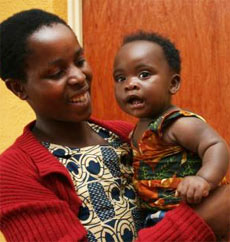fitness news
![]() ,
,![]()
Font size Women’s Health
Maternal and child health on the right track in Rwanda
– Reported, June 03, 2013
 In a region with some of the worlds worst indicators for maternal and child mortality, Rwanda is working hard to ensure mothers and their children have access to life-saving medical interventions.
In a region with some of the worlds worst indicators for maternal and child mortality, Rwanda is working hard to ensure mothers and their children have access to life-saving medical interventions.
I applaud the government of Rwanda for its efforts to ensure that you and your children have the same vaccines as children in developed countries, Mary Robinson, former president of Ireland and chair of the GAVI Alliance board, said at the launch of the fifth national mother and child health week in the northern district of Gicumbi on 29 November.
The government aims to vaccinate more than five million children and reach more than 300,000 mothers with tetanus vaccines and vitamin A. It also intends to de-worm all children between the ages of one and 16.
We have a very strong community health workforce of 60,000, who have been essential in getting health information to the lowest levels; these people know which child was born to whom and seek out children who have not been brought to the health centre for vaccination, said Richard Sezibera, Rwandas Minister of Health.
Through strong community health networks, mass media education and support from the GAVI Alliance and other partners, Rwanda has achieved routine vaccine coverage of about 97 percent for diphtheria, tetanus and Pertussis, also known as whooping cough. In 2009, it became one of the first African countries to introduce the pneumococcal conjugate vaccine into its routine immunization programme; pneumococcal disease kills an estimated 800,000 children under five annually, most in the developing world.
In 2011 Rwanda plans to introduce vaccines for rotavirus a diarrhoeal disease that kills more than half a million children globally every year and human papilloma virus (HPV), which can predispose women to cervical cancer. In 2011 the country plans to introduce vaccines for rotavirus a diarrhoeal disease that kills more than half a million children globally every year and human papilloma virus (HPV), which can predispose women to cervical cancer.
We are also making investments in infrastructure and health system strengthening so that hospitals have the capacity to deliver services to their populations, Sezibera said.
Rwandas Mutuelle national health insurance scheme where members pay approximately US$2 per year and 10 percent of their treatment costs has also greatly increased access to medical care for mothers and children. Mutuelle enrolment has risen from 44 percent in 2006 to more than 90 percent today.
When Melania Mukakabera, 38, was told by her health worker during a routine visit at the Rwesero health centre in Gicumbi that she needed to come back to the hospital to give birth, she did not hesitate she had been told about the importance of delivery in a medical centre, but more importantly, the facility was a clean, comfortable environment with friendly staff. Studies show that poor-quality health facilities and hostile health workers are some of the reasons mothers choose home deliveries over medically-assisted deliveries.
I had no problems and my child is healthy; I even came back to have my second child here, she told IRIN.
Women like Mukakabera are being encouraged to have no more than three children. Rwandan women have about 5.4 children on average, but family planning initiatives have seen contraceptive use grow from 10 percent in 2005 to 36 percent in 2008.
However, Rwanda still faces major hurdles in its effort to achieve universal access to healthcare for all mothers and children. While it has increased the number of hospital deliveries, about 47 percent of Rwandan women still give birth at home, without the assistance of trained medical personnel.
The health system also needs strengthening. Gicumbi District, for instance, with a total population of about 300,000 and 21 sectors, has 21 health centres. While some sectors have two health centres, four have none, leaving women and children in these areas too far from services to fully benefit from antenatal care, medically assisted childbirth or other maternal and child health services.
In addition, the large community health workforce can only compensate for some of the problems caused by its small formal medical workforce; Rwanda has just one doctor per 12,000 people and one nurse per 1,690. Child malnutrition is another issue that remains a major concern for the Rwandan government; an estimated 45 percent of children under five are chronically malnourished, which creates health problems and delays normal growth.
CREDITS.
For more Rwanda news Click Here